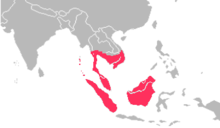Greater mouse-deer
| Greater mouse-deer | |
|---|---|
 |
|
| Scientific classification | |
| Kingdom: | Animalia |
| Phylum: | Chordata |
| Class: | Mammalia |
| Order: | Artiodactyla |
| Family: | Tragulidae |
| Genus: | Tragulus |
| Species: | T. napu |
| Binomial name | |
|
Tragulus napu (F. Cuvier, 1822) |
|
 |
|
The greater mouse-deer, greater Malay chevrotain or napu (Tragulus napu) is a species of even-toed ungulate in the family Tragulidae. It is found in Sumatra, Borneo and smaller Malaysian and Indonesian islands, and in southern Myanmar, southern Thailand and peninsular Malaysia. Its natural habitat is subtropical or tropical moist lowland forest.
Tragos is Greek for "goat" and –ulus in Latin means "tiny". Napu is a local name, from Malay "Napuh". The name "mouse-deer" refers to its small size and does not imply that it is a true deer. It is called "greater" because it is larger than other Tragulus species.
The greater mouse-deer is an even-toed ungulate. Although very small for an ungulate, the greater mouse-deer is one of the largest members of its genus. It is rivalled in size by Williamson's mouse-deer. It weighs 5 to 8 kg (11 to 18 lb). Its head-and-body length is 70 to 75 cm (2.30 to 2.46 ft) and its tail length is 8 to 10 cm (3.1 to 3.9 in). Its shoulder height is about 30 to 35 cm (12 to 14 in) It has a small, triangular head with a small, pointed, black nose and large eyes. Its long legs are as thin as a pencil. The hind legs are visibly longer than the front legs. The body is rounded. The fur on the upper part of its body is grey-buff to orange-buff. On the sides, the fur is quite pale, but darker along the midline. It is white underneath, especially on the neck, stomach, chest and chin. The male has neither horns nor antlers, but has small "tusks" – elongated canines in the upper jaws.
Greater mouse-deer are found in Sumatra, Borneo and smaller Malaysian and Indonesian islands, and in southern Myanmar, southern Thailand and peninsular Malaysia. They live near water, in tropical forests and mangrove thickets. It was thought to be regionally extinct in Singapore until it was rediscovered on an offshore island in 2008. Reports of its occurrence elsewhere are probably incorrect. They are terrestrial, but spend a lot of time in wet, swampy areas.
...
Wikipedia

